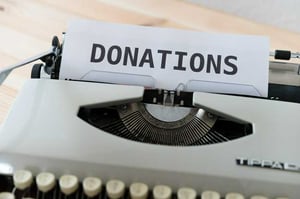 2 Corinthians 9:7 says that God loves a cheerful giver, but requesting donations for a church building isn't easy and writing a church building or repair letter can seem daunting.
2 Corinthians 9:7 says that God loves a cheerful giver, but requesting donations for a church building isn't easy and writing a church building or repair letter can seem daunting.
Don't worry. If you looking for a sample church building fund donation letter to help you write something effective and moving, you've come to the right place.
Keep reading to learn...
- Why church building donation letters work
- Receive an example of a letter
- Tips for writing a church building fund donation letter
- How to make a polite thank you note
- FAQs
- 35 Giving and Thank You Letter Templates for Every Church Occasion
Why Write a Letter?
When you spend so much time with members of your congregation you may wonder why you need to write a solicitation letter. After all, they've seen the call for donations in your bulletin and have even heard it mentioned during church announcements. Shouldn't they know that the church is in need?
There are a lot of good reasons why your church should consider drafting an official letter asking for donations. Here are a few reasons why we always recommend it and more details about 'how to ask' donation letters.
Stay Top of Mind
The message of your sermon probably stuck with your congregation, but the news around the progress of your new building fund probably didn't. That's why letters are important for keeping church needs on the minds of your congregation.
People are very busy. When people are focused on managing their job responsibilities and caring for their families, other news and needs can easily fall by the wayside.
Someone may be preoccupied with making dinner for the kids when they walk through the door, but their focus will snap back to church once they see a letter in the mail or a message in their inbox.
Showcase Your Specific Need
Since most churches are funded by their congregation, it's safe to assume that your new church building isn't the only thing you're getting donations for. The missionaries you support need their monthly donations, local charities you support need money and certain church employees need to be paid too.
When some people drop their money in donation plates they may not give much thought to where the money is actually going. In fact, some people may assume that they've already donated to the building fund because they gave their usual offering last Sunday!
A donation letter shows people you're collecting money for a specific reason. Aside from reminding readers you need money, it also lets them know that whatever they give now will be directly supporting the new building initiative. It's a good idea to link this content to any church donation pages on your website.
Alert Outside People
When you're fundraising for a new building the vast majority of your efforts are going to be focused on your congregation. Your flock will be eager to help, but there may be other people willing to donate that you haven't thought of.
Do you remember when your church helped raise money for a local little league team? When was the last time you reached out to that Christian electrician that gave you a discount on their services because you're a church? What about other institutions and organizations you've helped?
The truth is that your potential donor network is a lot larger than you'd think. Make outreach easier on your end by writing letters you can send out to ask for donations.
Donation Letter Writing 101: Your Go-To Template
We want to make sure you're prepared to write outstanding donation letters, that's why we're going to give you a sample fundraising letter for a church building. Be sure to pay attention to the content! We're going to break down some letter writing best practices that we demonstrated in the sample in the next section.
Sample Church Building Fund Donation Letter
[Date]
[Pastor's Name]
[Church]
[Street Address]
[City, State, Zip]
Dear [Donor Name],
We've had quite a year! Adding 35 new members to our church and funding two new missionaries have helped grow our congregation in more ways than one. I'd like to sincerely thank you for making all of the good we did this year possible with your generosity.
We have a lot of projects happening at [church], and as you may know, adding to our space has been a high priority on our list. A new building could help us do more community outreach and grow our congregation. We need your help making our new building dreams a reality.
You can help us raise the funds we need to add another building to our church. If you're able to do so, a small donation of $25 would help us reach our goal.
There are several ways you can contribute to our new building fund:
- Make a donation online at [website URL]
- Send us a check or cash in the pre-stamped envelope included in the letter
Every bit helps bring us closer to our goal, and we truly appreciate anything you can give. If you can't give at this time, consider spreading the word to your friends and family!
Also, there are plenty of other ways to support our church and mission. If you have any questions about how to help, please speak with our activities coordinator [].
Thank You Again,
[Printed name of pastor]
[Signature of pastor]

Tips for Writing Solicitation Letters
Our sample letter is less than 300 words, but you don't need to say a lot to get your point across.
If you want to raise funds for your new building, you can't just write a generic letter asking for funds. There are proper ways to write letters that can help you meet your fundraising goals.
Here are our tips on how to write solicitation letters that work.
Use Their Actual Name
Did you notice that we didn't start off with something generic like "Dear Congregation Member", "Dear Donor" or "To Whom It May Concern"? Names matter when you're writing donation letters.
When you're writing a donation letter, going for a personal approach is always best. It helps create a sense of empathy and connection with the reader. Starting off with something generic can come off as very impersonal. It also doesn't show the reader a sense of urgency.
In the reader's mind, they may assume that since you're sending out a generic letter you probably sent out a lot. After all, if they don't donate someone else is bound to. Simply adding their name shows that this is a message meant for them and that they have the power to help.
As a rule of thumb, make sure you use their preferred name. Addressing a letter to "Elizabeth" when you know them as "Beth" may not create the empathic connection you're hoping for.
Make Text Scannable
When you're writing a solicitation letter you don't want to be too wordy or long. Make your text short and to the point for maximum readability.
The language we used in our letter was effective, direct, and also simple. We didn't use any big words and got to the point of our letter relatively fast. We also used smaller paragraphs when we wrote copy and utilized bullet points.
Someone should be able to pick up your letter and understand the main point of it in about 15 seconds. Any longer than that, and you're risking losing their attention.
Start Off Positive
The beginning of our letter mentioned growing the congregation and supporting more missionaries. It may not directly have anything to do with raising money for a new building, but it can do a lot to help your cause.
Starting off with a positive anecdote or store helps the reader associate good things with your church.
The anecdote we shared also ties into a reason why we need the new space. It shows that your church is busy and adds a little justification about why you need a new building.
Focus on the Reader
We did say that starting off with some positive news is helpful, but you don't want to turn your anecdote into a full-fledged story. Your donation letter isn't a time to give a long update on what's happening at the church. In fact, the focus of your letter should be more about the reader and less about what you want to do.
Take a moment to reference our sample letter and notice how many times we used the words "you" and "your". Putting the reader first and foremost in your content can drive home just how important they are to your initiative.
Let them know how important they are and how their individual contribution can help. Focus on how their actions can directly affect the outcome of your fundraising efforts.
Ask For a Specific Amount
People like to follow directions, and your solicitation letter is no time to be vague. If you want to encourage people to donate give them a dollar amount they can contribute.
Be strategic about the dollar amount you ask for. If it's too low, you take away a sense of urgency and could lead people to think that you don't need funds that badly. If it's too high, people may think your church is being greedy and won't be motivated to donate.
Feel free to speak with your church's financial leadership before you determine a number, but aim for something that's substantial and attainable.
Don't worry about missing out on bigger donations by going for a middle ground number. People that have the means to donate more and want to do so will simply make their donation as planned. Some people who assumed they wouldn't be able to contribute enough can now see that making a helpful donation is possible.
Give People Multiple Ways to Donate
We're living and worshipping in a world where you may not be able to easily drop a check in a donation plate. Cash and checks used to be the preferred form of donations for churches, but there's a world of payment possibilities out there!
There are so many ways for people to contribute funds. If you don't use a virtual payment platform, now is the perfect time to sign up for one.
Giving people multiple ways to give also makes it easier for them to donate. Someone may not be willing to fill out a check our get cash to make a donation, but they won't have an issue sending money with a few clicks of a button.
Talk About the Benefits
Why do you want to have a new building for your church? Whether you're talking about adding a new wing or completely revamping your entire church, you're going to need to show readers why you're doing the work.
You don't have to write out a structured plan about how you want to use the space. We briefly mention that having a larger church could help grow the congregation and do more community outreach. That simple justification can be enough to open people's hearts and wallets.
Offer Up Alternatives
Times are tough right now, and it's possible that there are some people that won't be able to give your suggested amount. Instead of losing out on their help completely, let them know other ways they can contribute.
Mention that spreading the word is enough to help. The person you sent the letter to may not be able to donate, but their friend or coworker may be willing.
Also, try to mention a way to help that doesn't involve directly giving money. Offering to volunteer in the children's ministry may not help you get a new building, but it helps keep your church members engaged and allows them to help the congregation as a whole.
Go Digital
There is something to be said about the power of a mailed letter. Most people are used to communicating digitally, so getting a nicely written letter can stand out more.
Letters may make a statement, but you can reach a lot more people through email. Be sure to use the copy you wrote in an email campaign to try to get more donors. In some cases, email may be the best way to reach some potential donors.
Younger church members may be more receptive to donation emails, especially if they contain helpful links. Missionaries and people you've met at faith-based church retreats are also great candidates for emailed letters.
A Quick Note on Scheduling and Sending
Timing is everything when you're sending out solicitation letters. You may be on a tight schedule to get your funds together for construction to start, but rushing things could lead to unintended results.
If you send out letters too frequently, people may feel bombarded with charity requests. People that were once satisfied with your church and happy give may decide you're acting too desperate or too greedy.
Try your best to make a schedule for these donation request letters. Some people like to send them out once each quarter to spread everything out.
Remember, letters are likely only one way you're spreading the word about your donation needs. You can remind people in weekly newsletters, social media and even from the pulpit.
Thankfulness and Gratitude: Writing Your Thank You Letter
If you're planning on sending out a church building fund pledge letter, make sure you set aside some time to draft a thank-you letter.
Remember, giving to charity is more of an emotional decision than a financial one. The people that donated to your church building fund care about you and what you represent, and you should return the favor by showing how much you appreciate them.
There aren't a lot of rules associated with writing thank you messages, but if you want to write an impactful message, make sure you follow these tips.
Be Prompt
When you're writing a thank you note for donors timeliness is key. A prompt "thank you" letter can help donors feel appreciated and helps keep your church top of mind.
It's also important to note that sending out a timely thank you note can save you from a potential charity faux pas. There's nothing that can make a donor feel less special or more used than getting a request for charity before their other donation was acknowledged.
Don't Ask for More
Imagine spending time looking for the perfect wedding gift for a friend. You're happy to receive a thank you note from them, but you're surprised that they mentioned that they hope the gift you give them for their house warming is just as good.
Mentioning that there's another donation initiative for the church at the end of your letter may seem innocent, but it could rub some donors the wrong way. It can make your thank you seem less sincere, and may even make some people feel used.
Your thank you note should express gratitude for people's generosity and what they gave. You can send other letters or emails about other charity needs at a different time.
Reference Their History
Do you have a donor that's always happy to give whenever they have a chance to? Show some extra gratitude in your thank you note by mentioning how much you appreciated their continued contribution!
Thank you notes are all about showing appreciation, and you want to show the reader you remember their history of generosity. You don't have to name each thing they've done, but sometimes just adding the phrase "continued contributions/generosity" can do a lot to make someone feel appreciated.
Show Impact
The smallest donation can be enough to help your church reach its goal. Every donated dollar helps, and you can show that in your thank you note.
Think about all of the things you'll be able to do once the building is completed. Give the donor a taste of what their money is going to help accomplish when you write your letter:
"Your contribution can help make sure our kids have a safe and fun place to enjoy youth group."
"Thanks to your generosity, we're one step closer to having enough space to truly grow our congregation."
Charity Done Right
The sample church building fund donation letter you read in this post is only the first step in your fundraising journey. There's still plenty you can do to help ensure your church gets the funds it needs for whatever project you want to finance.
We've helped countless churches, non-profits, and other charity organizations over the decades reach their fundraising goals and we're ready to help yours.
Do you want an easier way to handle managing donations? Are you tired of using confusing digital platforms that make giving more confusing? Are you ready to modernize your fundraising efforts?
Sign up for our platform today so you make donating to your church as simple as clicking a button!
FAQs
How often should a church send out donation letters?
The frequency with which churches should send donation letters depends on the channel you use. If you’re sending them by mail, most experts recommend sending four per year – so one per quarter. When you send donation requests by email, a slightly more frequent cadence works best, with one message per month.
If you’re making donation appeals by social media, you can appeal even more often, sending several appeals per month. A key part of this process is varying up your letters and messages so donors don’t receive the same letter or email over and over – knowing they’ll start to tune out these repetitive messages because it looks like your church isn’t making much of an effort in sending them or asking for donations.
Be sure to explain why the money is needed and what it will be used for, knowing donors increasingly prefer to give to specific causes and projects, and they want to know how their gifts will be used.
Can digital donation requests be as effective as physical letters?
Digital donation requests have their pros and cons when compared to requests sent by mail. Email is a faster, cheaper option than standard mail and doesn’t require as much planning or legwork as mailing donation requests. Email also makes it easier to monitor the progress and results of your fundraising campaign.
However, research has shown that potential donors are more likely to receive a request sent by mail compared to one send digitally. A physical letter can have more of an impact with certain age groups, especially older donors who may prefer physical copies to digital ones. Also, keep in mind that some marketing and donation emails can be sent – either intentionally or unintentionally – to a person’s spam folder, meaning they won’t even see your message.
Consider factors such as budget, how much time and work you have to invest in your fundraising campaign and who your target audience is when choosing the best channel to send your donation requests.
What are some legal considerations to keep in mind when writing donation letters?
One key aspect of sending donation request emails is understanding opt-ins. When a person gives you their email with the direct understanding that you can email them, this is called express permission. If, on the other hand, some provides you with their contact information but doesn’t specify that they wish to receive donation or marketing emails, this is called implied permission.
In both cases, it’s best to abide by CAN-SPAM rules. These rules guide marketing emails and set specific standards for these messages.
When you obtain a person’s email address, you should also make it clear that by providing their information, they agree to receive marketing and donation emails from you. Provide a clear choice for them to opt in or opt out of receiving these messages. Also, keep in mind that you cannot accept contact information provided to you by a similar church or nonprofit because individuals provided their email to that organization and not to yours.
How to express gratitude to donors in follow-up communications?
When thanking donors, personalization is paramount. Few things will discourage a donor from giving again quite like a failure to thank them and nearly as bad is sending a cookie cutter thank you message with no personalization or effort put into its words.
Be sure to specifically thank each person for their gift and show that you took the time to understand what they gave and in what amount. Also, your message should share the impact their donation had. For example, if they gave to support a basketball camp your church hosted for local kids, share stories from the camp, tell them how many kids attended, how many meals were served and highlight uplifting stories from the event.
All of these steps help donors feel valued and remind them that they’re an invaluable part of the great work your church does rather than simply a source of money you send a church fundraising letter when you need support.
Can small churches benefit from donation letters as much as larger ones?
Congregations of all sizes can benefit from donation letter for churches. Just because your church is smaller and you’re more likely to know each member doesn’t mean that a well-crafted donation letter or email can’t have an impact. When you send a donation letter, it’s in a potential donor’s home and can serve as a reminder of the cause you’re asking them to support. Additionally, it can be tough to go in-depth with a donation message before, during or after a church service and sending a letter or email allows a donor to read your donation appeal in a setting where they feel comfortable and at ease instead of having a conversation about money around a crowd.
Donation letters for churches can also be used to support existing fundraising campaigns, reinforcing your message and keeping it front of mind for potential donors. Also, keep in mind that you may want to reach out to potential donors who don’t regularly attend your church or may not attend at all and sending out donation letters helps keep them connected to your church and expands your message’s reach further.
35 Giving and Thank You Donation Letter Templates for Every Church Occasion
Without a framework, or an example, crafting an appeal or a thank you message can be cumbersome. That's why we built a complete guide that not only offers 105 letter samples and donation letter templates for nearly any situation, but also offers specific guidelines to help.














